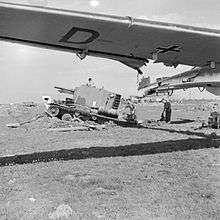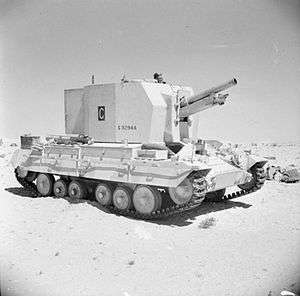Bishop (artillery)
| Ordnance QF 25-pdr on Carrier Valentine 25-pdr Mk 1 "Bishop" | |
|---|---|
|
Bishop in the Western Desert, September 1942 | |
| Type | Self-propelled artillery |
| Place of origin | United Kingdom |
| Service history | |
| In service | 1942 |
| Used by | British Commonwealth |
| Wars | Second World War |
| Production history | |
| Designed | 1941 |
| Manufacturer | Birmingham Railway Carriage and Wagon Company |
| Produced | 1942–1943 |
| Number built | 149 |
| Specifications | |
| Weight | 17.5 t (38,580 lb) |
| Length | 18 ft 6 in (5.64 m) |
| Width | 9 ft 1 in (2.77 m) |
| Height | 10 ft (3.0 m) |
| Crew | 4 (Commander, gunner, loader, driver) |
|
| |
| Elevation | -5° to +15° |
| Traverse | 8° |
|
| |
| Armour |
hull: 0.31–2.36 in (8-60 mm) superstructure: 0.51–2 in (13–51 mm) |
Main armament |
QF 25 pounder gun-howitzer with 32 rounds |
Secondary armament | 0.303 inch Bren light machine gun |
| Engine |
AEC A190 diesel 131 hp (98 kW) |
| Power/weight | 7.4 hp/tonne |
| Suspension | coil sprung three-wheel bogies |
Operational range | 90 mi (145 km) |
| Speed | 15 mph (24 km/h) |
The Bishop was the nickname of a British self-propelled artillery vehicle based on the Valentine tank, armed with the 25 pounder gun-howitzer, which could fire an 87.6 mm (3.45 in) 11.5 kg (25 lb) HE shell or an armour-piercing shell. A result of a rushed attempt to create a self-propelled gun, the vehicle had numerous problems, was produced in limited numbers and was soon replaced by better designs.
Design and development
The rapid manoeuvre warfare practiced in the North African Campaign led to a requirement for a self-propelled artillery vehicle armed with the 25-pounder gun-howitzer. In June 1941 the development was entrusted to the Birmingham Railway Carriage and Wagon Company. A prototype was ready for trials by August and 100 were ordered by November 1941.[1] The result was a vehicle with the formal title: "Ordnance QF 25-pdr on Carrier Valentine 25-pdr Mk 1".
The vehicle was based on the Valentine II hull, with the turret replaced by a fixed boxy superstructure with large rear doors. It was nicknamed the "Bishop" for its high mitre-like superstructure. [2]
Into this superstructure the 25-pounder gun-howitzer was fitted. As a consequence of the gun mounting the resulting vehicle had very high silhouette, which is a disadvantage in desert warfare.[1] The maximum elevation for the gun was limited to 15 degrees, reducing the range to 6,400 yards (5,900 m), about half that of the same gun on a wheeled carriage. The maximum depression was 5 degrees, traverse was 8 degrees, and the vehicle could also carry a Bren light machine gun. By July 1942 80 Bishops had been built; as the last 20 were being built an order for a further 50 was placed, with an option for a further 200 but the tender was abandoned in favour of the American M7 105 mm SP howitzer, named "Priest" in British service.[1]
Combat history
The Bishop first saw action during the Second Battle of El Alamein in North Africa and remained in service during the early part of the Italian Campaign. Due to its limitations and the Valentine's characteristic slow speed, the Bishop was poorly received. To increase range, crews would build large earthen ramps and run the Bishop onto them, tilting the vehicle back to increase the elevation. The Bishop was replaced by the M7 Priest (105 mm) and Sexton (25-pounder) when those became available in sufficient numbers and surviving Bishops were diverted for training in self-propelled gun tactics.[3]

British self-propelled guns with ecclesiastical names
A British self-propelled gun armed with the Ordnance QF 25-pounder in design from 1941 was nicknamed "the Bishop" as its appearance was said to resemble a bishop's mitre. A replacement, the US 105 Millimeter Howitzer Motor Carriage M7 was called "the Priest" by the British, as part of its superstructure was said to resemble a priest's pulpit. Following this line of names a 1942 self-propelled gun armed with the QF 6 pounder was named "the Deacon", and a 1943 carrier weapon with the QF 25-pounder was called "the Sexton". This practise was continued after the war with "the Abbot" and ended in 1993 with the introduction of the AS-90 (although delays and overruns in the development process for the AS90 earned it the nickname "choirboy" - because it had been "buggered by Vickers").
Notes
References
- Chris Henry, Mike Fuller - The 25-pounder Field Gun 1939-72, Osprey Publishing 2002, ISBN 1-84176-350-0.
- Trewhitt, Philip (1999). Armored Fighting Vehicles. New York, NY: Amber Books. p. 114. ISBN 0-7607-1260-3.
External links
| Wikimedia Commons has media related to Bishop self-propelled gun. |
